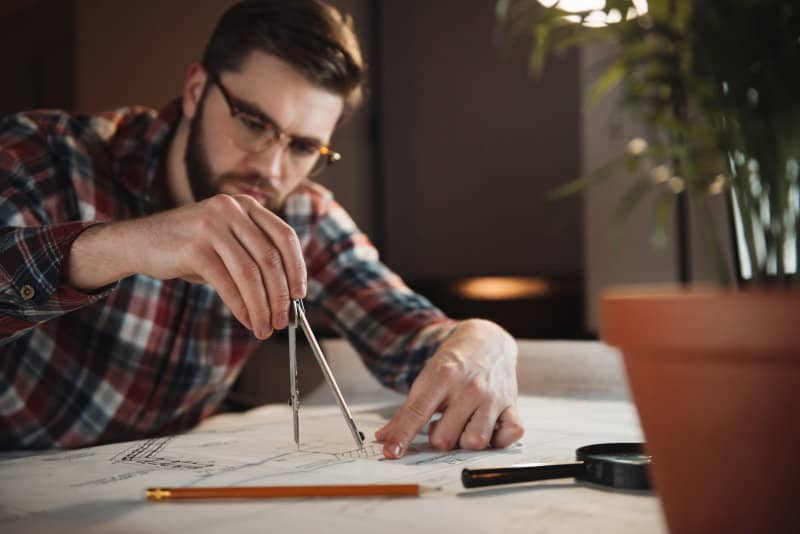Folks that don’t have facial hair can’t wrap their minds around the precision you need to shape it. Even the bushiest, wildest beard requires careful trimming to look right. A beard shaping tool can save a lot of time and heartache. There are plenty of fine beard shaping tools out there, but did you know you can make your own beard shaper at home?
With simple household items and little elbow grease, you can craft a great beard shaping tool at home. Moreover, the tool you create will be tailormade for your face! There are plenty of fantastic resources out there to help you.
Below, you will find a comprehensive guide on how to make a beard shaping tool at home. First, let’s talk about what makes a great beard shaper.
How Do Beard Shaping Tools Work?
Have you ever stared apprehensively into the mirror with a trimmer in your hand? You turn your face from side to side, looking for the best place to make your cut. One false move, and you could take a chuck out of your mustache or end up with an unsightly neckline.
Luckily, we are living in a golden age for beardsmen, and there are quite a few excellent tools out there to help you shape the perimeter of your beard.
In general, beard shaping tools are drafting guides for your face. These tools can be made of plastic, metal, or wood. They normally have at least one comb embedded in them to straighten out your beard as you prepare to trim.
A beard shaping tool might have one or two angles included, often with a curved cheek line on one side and a more boxed or linear option on the other side. Many also include an arched section that you can use to mark that devious neckline.
Some tools have other sections to square off the sides of your mustache or your sideburns.
What Should You Look for In a Beard Shaper?
There are scores of well-rated beard shaping tools out there, and it’s not always clear how useful a given product will be from a photo. Beard shapers can look like boomerangs or fidget spinners. If you don’t go in knowing what you want to accomplish with your facial hair, you might end up with a tool that’s unsuited to it.
Here are some variables you should consider with a beard shaping tool:
Shape and Size
Simple as it may sound, you want to think about how you want your beard to look. Then, you can determine which product can guide you to the best shape. Like we said, matching a tool to your face is not always intuitive. It’s a good idea to seek out videos of a potential shaper in action.
Additionally, always not the size of the beard shaper you’re considering. There’s no such thing as a standard man’s face, so it’s vital that you get a shaping tool that fits your specific mug.
Material
On average, most beard shaping tools are plastic. The good news here is that it keeps production costs down, resulting in a more affordable product. The bad news is that thin plastic beard shapers can be fragile and may wear out sooner than you’d like.
We contend that if you go with a plastic beard shaping tool, you should look for a transparent option. Clarity is the main value addition to a plastic product since it lets you see in real-time how your beard is shaping up.
If you want to go more upscale on your shaping tool, wood and metal products exist. Just remember that this tool will likely reside in your bathroom. Avoid materials that warp or tarnish easily. Stainless steel is probably your best option.
Maneuverability
A beard shaper can guide your clippers along the perfect curve or line, but they only work if you can hold the shaper and work a trimmer at the same time. Rather than selecting a tool with eight angles included, you might want to opt for a four-angle shaper that has a convenient handle to grip.
Combs
Beardsmen love a good comb-through, and it’s a good idea to find a beard shaping tool with a comb.
As a general rule, you should always comb or brush out your beard before you trim it. This will ensure that you don’t over-shape and end up with some wonky facial hair after you groom it. Having a comb embedded in your shaper makes this process much more manageable.
The one caveat we’d offer is that any edge of your shaping tool that has a comb is one fewer edge that can be used from shaping. We think that one comb is probably sufficient. Beyond that, you are sacrificing trimming angles.
Making Your Own Beard Shaping Tool: Setting Objectives

At this point, it should be abundantly clear that a beard shaper is a useful but somewhat rudimentary tool. Essential, it’s a stencil for your face. What is preventing you from making on at home?
The simple answer is nothing!
To make a beard shaping tool at home, however, you need to plan ahead. The adage in woodworking is “measure twice; cut once.” That is doubly true in homemade beard shapers. You need to measure twice to cut the angle that you will later use to trim your beard.
So, making a beard shaper at home primarily involves finding the best angle for your face and making a template on paper. Then you can use that paper template to cut a shaping tool from a more durable material. From then, it’s just a matter of smoothing a finished tool for everyday use.
Let’s get into the nitty-gritty of how to make your beard shaping tool at home.
Preparation – Securing the Necessary Tools

Regardless of what material you use for your final beard shaper, you will need the following items to create the template:
- A piece of paper and a pencil
- A straight edge, preferably a ruler
- A compass or protractor, if you are making a curved cheek perimeter
- A pair of scissors
That’s all you need to mark out the shape of your tool.
The other tools you need will depend upon the material of your final shaping tool. If you are working with cardboard, a utility knife will be sufficient. Wood requires a jigsaw. Plexiglass requires a specialized plastic knife.
Step 1 – Finding the Angle
To begin, you will need to select the angle for your beard tool. This is the most important and exciting part of the process because it can tailor your shaping tool to your face. You will do this on paper, then transfer the template to the material you are using for the shaper.
Unfortunately, this part of the process will require us to revisit high school geometry. We promise this won’t be too in-depth.
We recommend you begin this process by measuring the distance between the top of your sideburn and the place where your mustache and bear meet. You can mark this distance from the edge of your paper to the center.
If you trim your cheek line straight, this might be the extent of your template. Your tool will be a four-sided shape with two right angles and a sloping top measured to the length of your cheek.
If you want a curved cheek line, this is the moment you want to bust out the old compass and/or protractor. Since you have already marked out the length of your cheek on the paper, you now need to draw a circular curve from one side of the line to the other. Don’t worry if you screw up a couple of times. Just keep making curves until you have one that works.
Then, all you need to do is cut out the shape you’ve sketched.
As a side note, we recommend you make a curved shaping tool even if you usually have a straight cheek perimeter. We suggest this because you can hold this tool to your neck – from under the corner of your jaw to an inch or so above your Adam’s Apple – and mark a clean neckline on either side of your throat!
Step 2 – Choosing the Best Material
To be candid, the best material for your homemade beard shaper might be the material you already have. It might also be the material you already have the means to cut.

After a year and a half in quarantine, we wouldn’t be shocked to find out that you have a surfeit of cardboard boxes around the house. These are great for a quick homemade beard shaping tool. Whether you’re hacking up a shoebox or the backing of a legal pad, you can transfer your shape from paper to cardboard exceptionally quickly.
Of course, cardboard is cheap and easy, but it doesn’t stand up to wetness incredibly well.
If you have some good woodworking tools, a composite board or thin plywood will do very well. A piece of plexiglass is even better, though most guys will need to buy a dedicated tool to cut it. With that said, you can find a super-sharp plastic knife like the Red Devil 1170 for surprisingly little cash online.
Step 3 – Cutting the Tool
Let’s begin with a serious word of caution. Whether you are cutting cardboard, wood, or plastic, you need to be careful. You should remember the following three safety tips:
- Always wear safety equipment, most importantly gloves.
- If you’re using a power-cutting tool, wear protective glass over your eyes.
- Always cut away from your body.
Now, with those cautionary notes in mind, you can proceed to transfer your paper shaping tool to a hardier medium. You can tape or pin the paper template down. Alternatively, you can place it on your material and outline. For plexiglass and composite wood, this might require a grease marking pencil.
Once you have your shape marked out, you can cut. Here are some tips for cutting each type of material:
| Cardboard | An extraction knife or box cutter will work well to match your template’s shape. Just be sure to place a buffer under cardboard so you don’t gouge the table underneath. |
| Wood | Try to place the template along one corner of your wood to minimize the number of cuts your need to make. Be sure to clamp your wood. A circular saw works well for straight cuts. Curved sides will require a jigsaw. |
| Plexiglass | Be sure the plastic sheet has been wedged into place. Plastic knives may require several swipes to cut all the way through the plastic. |
Step 4 – Finishing Procedures
Once your shaping tool is cut, you need to finish it for use. In general, the objective is to minimize the chance of splinters or cuts from round, sharp edges.
With cardboard, a good finishing option is wrapping the beard side with duct tape. This will prevent water infiltration when you place it against your potentially wet face. Will it look super attractive? Not really, but then again, we’re talking about a homemade cardboard beard shaper. It’s not going to win any design awards.
If you are working with wood or plastic, you need to sand down the edges of your tool. You can do this with a power sander or with sandpaper and a good amount of energy. For wood, you also need to sand down any unfinished sides. While you’re at it, why not apply a little stain for a luxurious finish. Just make sure the stain can handle moisture and won’t irritate your face!
Stenciling Options
That is how you make a beard shaping tool at home. All well and good, but you might notice that this tool would only include one angle. What if you want to make something with multiple shaping options?

As luck would have it, there are plenty of spec illustrations for retail shapers online. Nothing is stopping you from printing one of them out and using it as a stencil to recreate a multi-angle tool. You might even end up with a superior product since you can resize the image for your face size.
Bear in mind, using a stencil to create a more complex beard shaper will require more advanced cutting. These products have many angles and wedges cut out. You will want to position the template so that its flat edges line up with the edges of your material.
Comparison to the Retail Brands
This all begs the question: is it worth the time and labor needed to make your own beard shaper at home?
Without a doubt, you will find some cash savings if you use materials you already have around the house. Beard shaping tools are not the priciest men’s grooming products, but they aren’t free either!
We think the actual value of making a beard shaper at home is that you can modify it for your facial hair. The size and shape of your shaping tool should jibe with your face. Rather than comparison shopping ad nauseum for the right-sized retail option, you can simply measure and cut.
Of course, you will need to sacrifice some bells and whistles. There’s no denying that a homemade cardboard tool will be less durable even than a low-cost plastic model. Still, it will get the job done. Also, unless you want to be really crafty, you won’t be able to embed a plastic comb into your shaping tool. That might make the alternate combing and shaping processes a bit cumbersome.
Nonetheless, we believe making a beard shaping tool at home is a worthwhile, diverting endeavor. If, however, you want to go the retail route for your shaping needs, here are a couple options we love:
- Monster&Son Beard Shaping Tool is a wonderful transparent plastic tool with multiple angles, covering cheeks, necks, mustaches, and sideburns. It’s also got a nice embedded comb.
- MasterManner’s Adjustable Beard Shaping Tool has a rotating part that allows for multiple angles on one edge. It’s a good solution for multiple faces and multiple parts of the same face.
The Bottom Line
Let’s be honest here: guys are way too confident in their ability to trim their facial hair. A high-quality beard shaping tool is an excellent option to prevent unfortunate clipper mishaps.
Sure, you can go online and get any number of beard shapers, but we recommend you take a swing at crafting your own at home. It will be a fun project, and your beard will thank you for the extra care and attention.
Beard shapers are a great way to avoid unsightly trimming mistakes. But is there a point of no return on facial hair? Please take a look at our recent post on when it’s time to give up on your beard.

